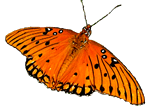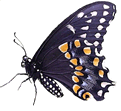How to Create a Butterfly Friendly Garden
One note for dedicated gardenners who may be appalled at the idea of actually inviting caterpillars in for lunch... Very few butterfly species ever cause harm to your garden plants! If they do become a nuisance, if for instance cabbage Whites are decimating your nasturtiums - picking the larvae off by hand is a simple task... done.
If you already have a growing herb garden, you are well on the way to having a full fledged Butterfly friendly garden already! Most Butterflies love the flowers of herbs. If you have the beginnings of a Butterfly garden, you might want to consider adding an herb section to your plans. Reserving a section of your yard for native flowering plants and for weeds like dandelion, nettle, and milkweed should also be added somewhere nearby to help guarantee a good variety of butterflies.
Needless to say, it's best to avoid using any pesticides anywhere near the area you are inviting Butterflies in to.
Butterflies need shelter from predators and wind. Hedges are ideal but groups of small trees and shrubs, or fences and trellises covered with vines are also excellent! Honeysuckle and butterfly bushes are perfect anchor points to develop the Butterfly Garden from. Then you can add different sections left, right, up or down from there. (Herbs, native plants, a vine spot... whatever pleases you...) If your region is host to a particular butterfly species, or if you are interested in attracting a certain species of Butterfly, see the 'What Attracts Whom?' table below.
Butterflies can't drink from birdbaths or other open water, but give them a damp spot of wet sand or dirt and they'll often flock around it. In some species, it is Common practice for young bachelor butterflies to "puddle" ... Perhaps the equivalent of their human counterparts visiting the local pub after work.
Hatching and Growing Baby Butterflies
I can't think of anything more magical and inspiring than the metamorphosis of a caterpillar into a butterfly.To watch this drama from opening curtain to finale, you need a caterpillar or larvae, the leaves it eats, a little moisture, a can and patience.
Later on you'll need to make a simple cage.
Common butterfly species lay their eggs on particular plants (usually trees), and it is often on the underside of their leaves that you'll find caterpillars.
Some of these plants/trees and the butterfly larvae they host are milkweed, dogbane (Monarch); cow parsnip, fennel, dill (Swallowtails; cottonwood, wild cherry, willow, maple, alder (tiger Swallowtail); willow, cottonwood (Mourning Cloak); birch, alder, willow, gooseberry, currant, wild rhododendron (Angelwing); cabbage, mustard, nasturtium (cabbage White); thistle, pearly everlsting (Painted Lady).
When you have found your chosen caterpillar, put it in a large can along with some of the kind of leaves it was feeding on. Clean and add fresh leaves as needed, along with some twigs. Your caterpillar may shed its skin several times as it grows. Eventually, it will shed all of its legs except those on its first three body segments, indicating that it has reached full growth and will soon begin to spin its cocoon, attaching it to a twig or the bottom of the can.
The pupa (cocoon or chrysalis) stage lasts from ten days to eight months, depending on the species (this is where the patience comes in). You can move the pupae to a cage at this point. A cylinder of wire screen or one-quarter-inch hardware cloth upended on a paper plate with another paper plate for a top is sufficient.
Put a layer of peat moss or soil at the bottom, and spray the chrysalis lightly from time to time with fresh water to keep it from drying out (don't soak it!). Watch for any movement and change in the appearance of the cocoon, because the hatching process can be quite short.
Don't interfere with natures process at any point!.
Although it may pull itself from the cocoon in only a few minutes, the emerging butterfly needs time to pump air and blood through its body and wings, and its outer skeleton needs to harden. The butterfly is usually ready to fly in about half an hour without any help from you.
What Plant Attracts Which Butterfly?
| This Plant | Attracts this species of Butterfly: |
|---|---|
| Alfalfa | Eastern Black Swallowtail, Orange Sulphur, Dogface, Large Wood Nymph |
| Aster | Checkered White, Orange Sulphur, Question Mark, Painted Ladies, Red Admiral, Buckeye |
| Black-eyed Susan | Great Spangled Fritillary, Pearly Crescentspot |
| Butterfly Bush | Swallowtails, Mourning Cloak, Comma Angelwing, Painted Ladies, Red Admiral |
| Daisy | Pearly Crescentspot, Red Admiral, Queen |
| Dandelion | Cabbage shite, Common sulphur, Comma Angelwing, Red Admiral |
| Dogbane | Spicebush Swallowtail, checkered White, Common Orange Sulphur, Gray Hairstreak, Spring Azure, Pearly Crescentspot, Mourning Cloak, American Painted Lady, Buckeye |
| Goldenrod | Common Orange Sulphur, Gray Hairstreak, American Painted Lady, Red Admiral, Viceroy |
| Lantana | Swallowtails, cabbage White, Gulf Fritillary |
| Lupine | Common blue |
| Marigold | Milbert's tortoiseshell, American Painted Lady |
| Milkweed | Swallowtails, Checkered Cabbage White, Common Orange Sulphur, Gray Hairstreak, Spring Azure, Pearly Crescentspot, Common Blue, Great Spangled Fritillary, Question Mark, Mourning Cloak, Painted Ladies, Red Admiral, Viceroy, Monarch, Queen |
| Mint | Swallowtails, Cabbage White, Gray Hairstreak, Painted Ladies, Red Admiral, Monarch, Large Wood Nymph |
| Privet | Spring Azure, Painted Ladies, Red-spotted Purple |
| Purple Coneflower | Silvery blue, Great Spangled Fritillary |
| Queen Anne's Lace | Eastern Black Swallowtail, Gray Hairstreak |
| Red Clover | Cabbage White, Great Spangled Fritillary, Painted Ladies, Red Admiral |
| Scabiosa | Painted Ladies |
| Sweet Pea | Gray Hairstreak |
| Sweet Pepperbush | Spicebush Swallowtail, Question Mark, American Painted Lady, Red Admiral |
| Thistle | Swallowtails, Dogface, Gulf Fritillary, Pearly Crescentspot, Milbert's Tortoiseshell, American Painted Lady, Red Admiral, Viceroy, Monarch |
| Verbena | Great Spangled Fritillary |
| Winter Cress | Checkered White, Gray Hairstreak, Spring Azure, Pearly Crecentspot |
Additional flowers and plants that attract butterflies.





